NAND gate
| INPUT | OUTPUT | |
| A | B | A NAND B |
| 0 | 0 | 1 |
| 0 | 1 | 1 |
| 1 | 0 | 1 |
| 1 | 1 | 0 |
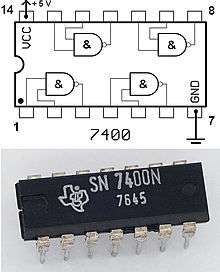
In digital electronics, a NAND gate (NOT-AND) is a logic gate which produces an output which is false only if all its inputs are true; thus its output is complement to that of an AND gate. A LOW (0) output results only if all the inputs to the gate are HIGH (1); if any input is LOW (0), a HIGH (1) output results. A NAND gate is made using transistors and junction diodes. By De Morgan's theorem, a two-input NAND gate's logic may be expressed as AB=A+B, making a NAND gate equivalent to inverters followed by an OR gate.
The NAND gate is significant because any boolean function can be implemented by using a combination of NAND gates. This property is called functional completeness. It shares this property with the NOR gate.
Digital systems employing certain logic circuits take advantage of NAND's functional completeness.
The function NAND(a1, a2, ..., an) is logically equivalent to NOT(a1 AND a2 AND ... AND an).
One way of expressing A NAND B is , where the symbol signifies AND and the bar signifies the negation of the expression under it: in essence, simply .
Symbols
There are three symbols for NAND gates: the MIL/ANSI symbol, the IEC symbol and the deprecated DIN symbol sometimes found on old schematics. For more information see logic gate symbols. The ANSI symbol for the NAND gate is a standard AND gate with an inversion bubble connected.
 |
 |
 |
| MIL/ANSI Symbol | IEC Symbol | DIN Symbol |
Hardware description and pinout
NAND gates are basic logic gates, and as such they are recognised in TTL and CMOS ICs.
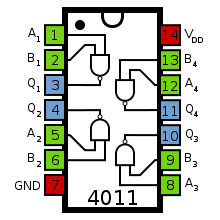
Implementations
The NAND gate has the property of functional completeness. That is, any other logic function (AND, OR, etc.) can be implemented using only NAND gates.[1] An entire processor can be created using NAND gates alone. In TTL ICs using multiple-emitter transistors, it also requires fewer transistors than a NOR gate.
 NMOS NAND gate |
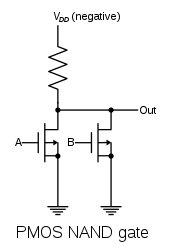 PMOS NAND gate |
 CMOS NAND gate |
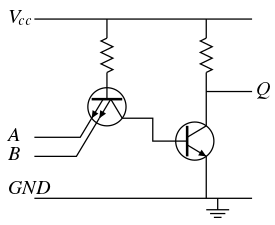 TTL NAND gate |
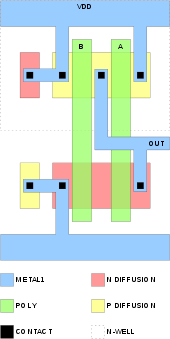 The physical layout of a CMOS NAND |
 Die of a 74AHC00D quad 2-input NAND gate manufactured by NXP Semiconductors |
Silicon implementation of 4 NAND gates in an integrated circuit |
Alternatives
If no specific NAND gates are available, one can be made from NOR gates, because NAND and NOR gates are considered the "universal gates", meaning that they can be used to make all the other gates.[1]
| Desired gate | NOR Construction |
|---|---|
 |  |
See also
References
External links
- TTL NAND and AND gates – All About Circuits
| Wikimedia Commons has media related to NAND gates. |
